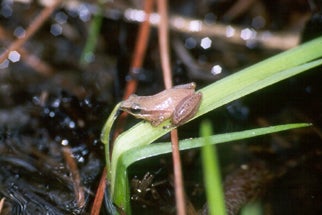SCIENTIFIC NAME:
Pseudacris ocularis (Bosc and Daudin)
OTHER NAMES:
None.
STATUS: R
are and peripheral in Dougherty Plain. Known from only four localities in southeastern Houston County. MODERATE CONSERVATION CONCERN.
DESCRIPTION:
The smallest (max. snout-vent length = 20 mm [0.8 in.]) land vertebrate in North America. Quite variable in color; can be gray, tan, brown, or brick red. A prominent dark-brown stripe extends from the pointed snout through the eye and onto the side. A dark mid-dorsal stripe, and faint dorsolateral stripes may be present. Toes have expanded tips, but little webbing. Belly yellowish white (Mount 1975, Franz and Chantell 1978). May be confused with recently metamorphosed, and thus tiny, southern chorus frogs and southern cricket frogs (Martof et al. 1980, Ashton and Ashton 1988).
DISTRIBUTION:
Coastal Plain from southeastern Virginia to the southern tip of Florida and west to ChoctawhatcheeBay in the Florida Panhandle (Harper 1939, Moler 1982, Conant and Collins 1991, Jensen 1994). Distribution barely enters Alabama, occurring only in four documented locations in the southeastern corner of the southeasternmost county (Houston) in the state (Mount 1975).
HABITAT:
Prefers relatively open grass and sedge-dominated wetlands associated with cypress ponds, roadside ditches, pine flatwoods, and savannas (Harper 1939, Wright and Wright 1949, Mount 1975, Gibbons and Semlitsch 1991).
LIFE HISTORY AND ECOLOGY:
Breeding season rather protracted compared with other native Pseudacris spp., occurring January to September (Harper 1939). Males have a tinkling, insect-like call issued from vegetative perches up to one meter (three feet) above the water (Harper 1939, Wright and Wright 1949). One hundred to 200 eggs per female are laid singly or in small clusters in shallow, rain-filled depressions and the edges of semi-permanent ponds (Harper 1939, Wright and Wright 1949, Mount 1975; Gibbons and Semlitsch 1991, Bartlett and Bartlett 1999). Tadpoles graze on algae and aquatic vegetation and metamorphose in 45 to 70 days (Wright and Wright 1949). Adults, active both night and day, eat a wide variety of small arthropods associated with leaf litter and soil (Marshall and Camp 1995). Cryptically colored and patterned to avoid detection from predators; can leap relatively far when escape is required (Wright and Wright 1949). Wolf spiders are documented predators (Owen and Johnson 1997), although others surely exist.
BASIS FOR STATUS CLASSIFICATION:
Common and apparently secure throughout most of distribution, but somewhat vulnerable to extirpation in Alabama because of very few locations from which they occur. All known sites are on private lands where habitat alteration is difficult to prevent.
Author: John B. Jensen






